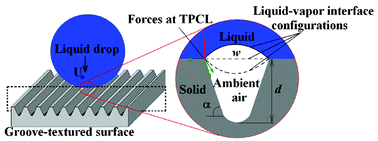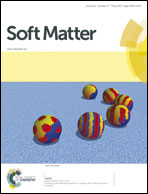Transition from Cassie to impaled state during drop impact on groove-textured solid surfaces
Abstract
Liquid drops impacted on textured surfaces undergo a transition from the Cassie state characterized by the presence of air pockets inside the roughness valleys below the drop to an impaled state with at least one of the roughness valleys filled with drop liquid. This occurs when the drop impact velocity exceeds a particular value referred to as the critical impact velocity. The present study investigates such a transition process during water drop impact on surfaces textured with unidirectional parallel grooves referred to as groove-textured surfaces. The process of liquid impalement into a groove in the vicinity of drop impact through de-pinning of the three-phase contact line (TPCL) beneath the drop as well as the critical impact velocity were identified experimentally from high speed video recordings of water drop impact on six different groove-textured surfaces made from intrinsically hydrophilic (stainless steel) as well as intrinsically hydrophobic (PDMS and rough aluminum) materials. The surface energy of various 2-D configurations of liquid–vapor interface beneath the drop near the drop impact point was theoretically investigated to identify the locally stable configurations and establish a pathway for the liquid impalement process. A force balance analysis performed on the liquid–vapor interface configuration just prior to TPCL de-pinning provided an expression for the critical drop impact velocity, Uo,cr, beyond which the drop state transitions from the Cassie to an impaled state. The theoretical model predicts that Uo,cr increases with the increase in pillar side angle, α, and intrinsic hydrophobicity whereas it decreases with the increase in groove top width, w, of the groove-textured surface. The quantitative predictions of the theoretical model were found to show good agreement with the experimental measurements of Uo,cr plotted against the surface texture geometry factor in our model, {tan(α/2)/w}0.5.


 Please wait while we load your content...
Please wait while we load your content...